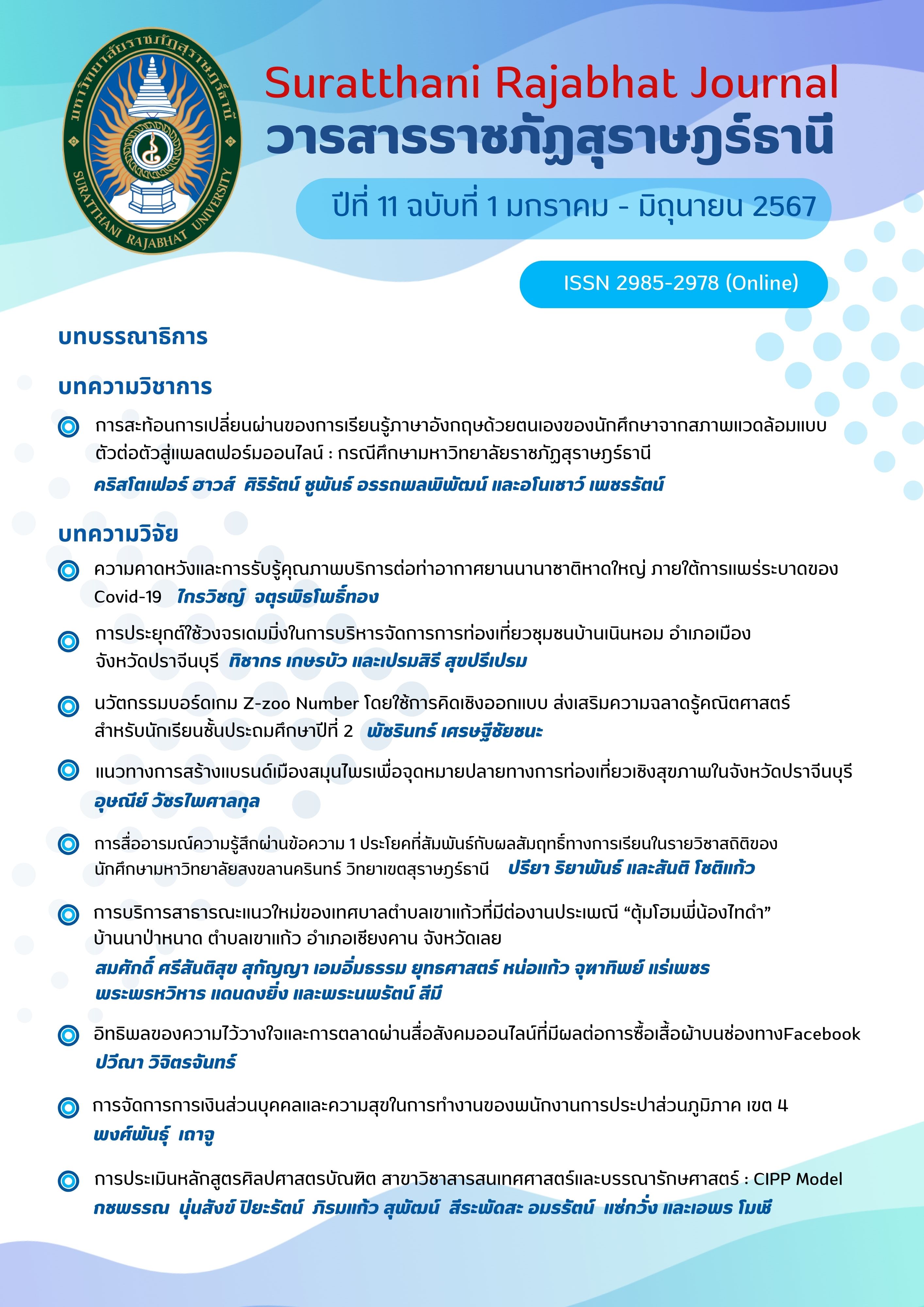Guidelines for Building the Herbal City Brand as a Wellness Tourism Destination in Prachinburi Province
Main Article Content
Abstract
The objectives of the study were to: (1) study the behaviors of wellness tourists in Prachinburi Province, (2) examine the perceptions of the herbal city's image, and (3) propose guidelines for establishing the herbal city brand as a wellness destination in Prachinburi. Qualitative data were collected using a semi-structured interview approach with ten key informants selected through purposive sampling, verified using data triangulation. Quantitative data were collected using a questionnaire administrated to a sample group of 370 tourists selected through convenience sampling. The data were analyzed using descriptive statistics and the Chi-Square test at a significant level of .05. The average reliability coefficient was found to be 0.725. The results indicated that most tourists traveled to purchase herbs for nourishing and promoting their health. They obtained information primarily from social media platforms and highly recognized the herbal city's image associated with natural resources. This related to their experiences, information sources, travel purposes, and places to visit. The study identified an opportunity to enhance the value of existing resources through the implementation guidelines of tourist city branding based on the 7Ps concept, including Potential, Positioning, Personality, Performance, Promotion, Partnership, and Possibility.
Article Details

This work is licensed under a Creative Commons Attribution-NonCommercial-NoDerivatives 4.0 International License.
References
Bangkokbiznews. (2021). Approved the 2nd National Action Plan on Herbs to push herbs for economic crops, (in Thai). https://www.bangkokbiznews.com/social/980160
Beerli, A., & Martin, J. D. (2004). Tourist’s Characteristics and the perceived image of tourist destination: a quantitative analysis--a case study of Lanzarote Spain. Tourism management.
Blain, C., Levy, S.T. & Ritchie, J.R.B. (2005). Destination Branding: Insights and Practices from Destination Management Organizations. Journal of Travel Research, 43(4), 328-338. https://doi.org/10.1177/004728750527464.
Cronbach, L.J. (1990). Essentials of psychological testing. (5th ed.). New York: Harper & Row. pp. 202-204.
Cochran, W. G. (1977). Sampling Techniques (3rd ed.). New York: John Wiley & Sons.
Department of Thai Traditional Medicine and Alternative Medicine. (2016). Herbal City Development Strategy. Nonthaburi: Office of the National Herbal Policy Committee.
Esichaikul, R. (2017). Health Tourism, (in Thai). http://www.ms-stou.org/archives/.
Faculty of Abhaibhubejhr Thai Traditional Medicine. (n.d.). History and development Abhaibhubejhr College of Thai Traditional Medicine Prachinburi. http://thaimed.buu.ac.thhistory/Fronntd/index.
Florek, M. (2005). The country brand as a new challenge for Poland. Place Branding, 1, 205-214.
Gilmore, F. (2002). A country - can it be repositioned? Spain - the success story of country branding. Journal of Brand Management, 9, 281-293. https://doi.org/10.1057/palgrave.bm.2540078
Goodrich, J. N. (1994). Health tourism: A new positioning strategy for tourist destinations. Journal of International Consumer Marketing, 6(3-4), 227-238. https://doi.org/10.1300/J046v06n03_12
Heath, E. and Wall, G. (1992). Marketing tourism destinations: A strategic planning approach. New York: John Wiley & Sons, INC.
Kispredarborisuthi, B. (2011). Research Methodology in Social Sciences, 11th ed. Bangkok: Dharmasarn Printing, Thailand, (in Thai).
Kotler, P. (2000). Marketing management. New Jersey: Prentice - Hall.
Kotler, P. (2014). rEnglewood Cliffs: Prentice Hall.
Keller, K. L. (2008). Strategic brand management: Building, measuring and Management brand equity (2nd ed.). Upper Saddle River, NJ: Prentice Hall.
Ministry of Public Health. (2016). Guidelines for the development of a comprehensive Wellness City: A model for leading provinces, Prachinburi, (in Thai). Department of Health Service Support. https://www.hfocus.org/content/2016/11/12935
Morgan, N. J., Pritchard, A., & Piggott, R. (2004). Destination branding: Greating the unique destination proposition (2nd ed.). Oxford: Elsevier Butterworth Heinemann.
Nations online business. (2016). Abhaibhubejhr opened the house for give a healthy food recipes. https://www.prachachat.net/news_detail.PHP?Newsid=1482902653
Nunnally, J.C. & Bernstein, I.H. (1994). The Assessment of Reliability. Psychometric Theory, 3, 248-292.
Owat, P., & Sawang, S. (2021). Brand Image Factors Affecting the BuyingDecision of Herbal Products in Pathum Thani Province, The 16th National Graduate Research Conference, 1024-1036, (in Thai).
Pike, S., Bianchi, C., Kerr, G. & Patti, C. (2010). Customer-based brand equity for Australia as a longhaul tourism destination in an emerging market. International Marketing Review, 27(4), 1-25. https://doi.org/10.1108/02651331011058590
Robbins, S.P. (2003). Organizational behavior. 10th ed. Englewood Cliffs, NJ.: Prentice-Hall.
Sereerat, S. (2007). Customer behavior. Bangkok: Pattana Co., Ltd. P.S. Publishing Co.,Ltd. Printing, Thailand, (in Thai).
Mechinda, P. & Siriwan, S. (2011). New Marketing Management. Bangkok: Dharmasarn Printing, Thailand, (in Thai).
Suriyawittayawate, C. (2019). From national strategy 20 years to national master plan for Thai herbs development by integrating agricultural education. Journal of Industrial Education, 18(1), 240-250, (in Thai). https://ph01.tci-thaijo.org/index.php/JIE/article/view/157072/134936
Tantivejkul, P. (2003). Health Tourism, TAT Review Magazine, 22(1), 29-41. (in Thai).
The Public Relations Department. (2021). Asean Information Center, (in Thai). http://www.aseanthai.net/mobile_detail.php?cid=&nid=11736.
Tourism Authority of Thailand. (2015). Wellness Tourism, (in Thai). http://thai.tourismthailand.org/


